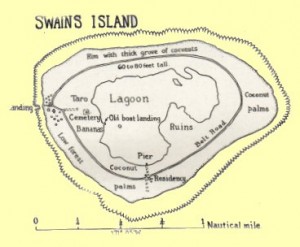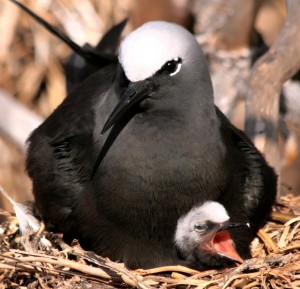Week 17 – 30 October 2016:
Where Did You Say It Is?
There cannot be too many bits of land that humans have never visited. There are, however, places that people have found and occupied, but later abandoned and forgotten. In contrast, birds tend to discover sites, settle in, and stay. Some of us dream of travelling to sites that have been abandoned by everything except birds.
Swains Island is just such a locale. A circular atoll in the South Pacific Ocean, the island is part of the Tokelau group, which are a dependency of New Zealand. Swains Island itself is administered by the United States under the umbrella of American Samoa. It is, quite frankly, hard for me to imagine why the United States would want anything to do with Swains. The island is about 2 km long and 1.5 km wide, with a central lagoon full of brackish water. Nowhere does the island poke more than 9 m above the sea, and drinking water is hard to collect. The island’s dominant plant is the coconut palm, but shorefront shrubland, marsh and forest can also be found. Although Swains Island was a coconut plantation in the past, and was occupied year-round, it is now completely uninhabited.
Except, of course, for periodic visits by biologists curious to see which creatures call the island home. The most recent visit was by members of the Department of Marine and Wildlife Resources in American Samoa in September of 2012. Andrew Titmus, conducting research in American Samoa for a doctoral degree at the University of Hawaii, was invited to inventory birds on the island while other researchers looked at insects, coconut crabs, sea life and vegetation. Another key member of the group was Nicole Arcilla, the chief wildlife biologist of DMWR. The group visited Swains Island for six days, 36 years after the previous survey.
Titmus explained to me that the team got to Swains on a chartered boat that normally ferries people American Samoa and Western Samoa. “The journey took the better part of a day and once there we needed to use a small boat to ferry equipment and supplies to the island through a small opening in the reef.”
Titmus and his crew walked the coastline of the island twice, counting every bird they encountered. They documented the birdlife along nine transects through the island’s vegetated habitat, starting at the coast and ending at the central lagoon. They also spent three evenings at sea, watching for rare or transient bird species.
The efforts of Titmus et al. revealed 19 species of birds, some rare and some common. Almost all were seabirds or shorebirds. The Bristle-thighed Curlew, Sanderling, and Brown Booby were represented by just two individual each. In contrast, 7,092 Black Noddys and 4,412 White Terns were counted.
To anyone familiar with waterbirds, it is interesting that: “All nesting and roosting seabirds were observed within trees, with no birds present on the ground or beach.” Titmus and his crew attributed this behaviour to introduced predatory mammals. Even though the island’s feral pig population has been eradicated, there is still a small group of feral cats, and Pacific rats were common everywhere.
This lead Titmus et al. to a wonderful suggestion. If a concentrated effort was to eliminate the cats and rats on Swains Island, and if coconut palms were replaced by native trees that better suited birds, the island could become an important site for nesting seabirds. It is even possible that shearwaters that burrow into the soil to nest might take up residency on Swains.
Titmus wrote to say that “while we were on the island, we camped on the beach by the old village site and copra shed, and there is still the remains of a trail between the village site and the family residence site where there is a dilapidated house and a small graveyard.” To me that sounds like a pretty idyllic spot to study birds.
Titmus, A. J., N. Arcilla and C. A. Lepczyk. 2016. Assessment of the birds of Swains Island, American Samoa. Wilson Journal of Ornithology 128:163-168.
Photocredits: Map of Swains Island - www.janeresture.com/tokelau_islands/swains.htm; Black Noddy with chick by Pete Leary (US Fish and Wildlife Service) - www.usgs.gov/media/images/black-noddy-chick



